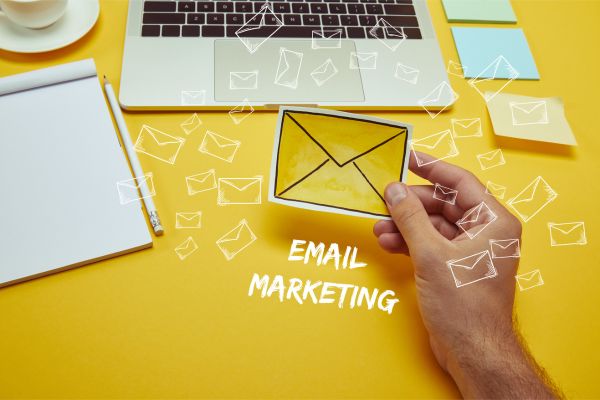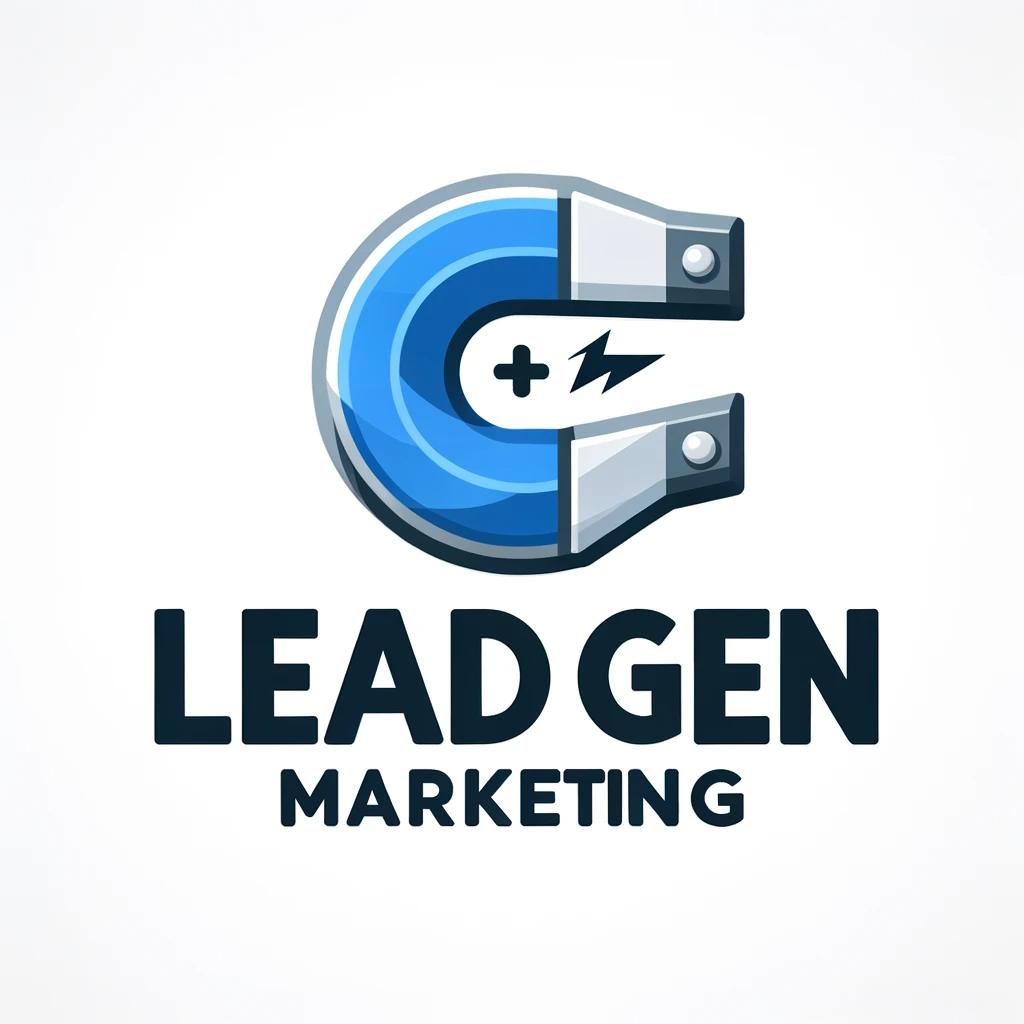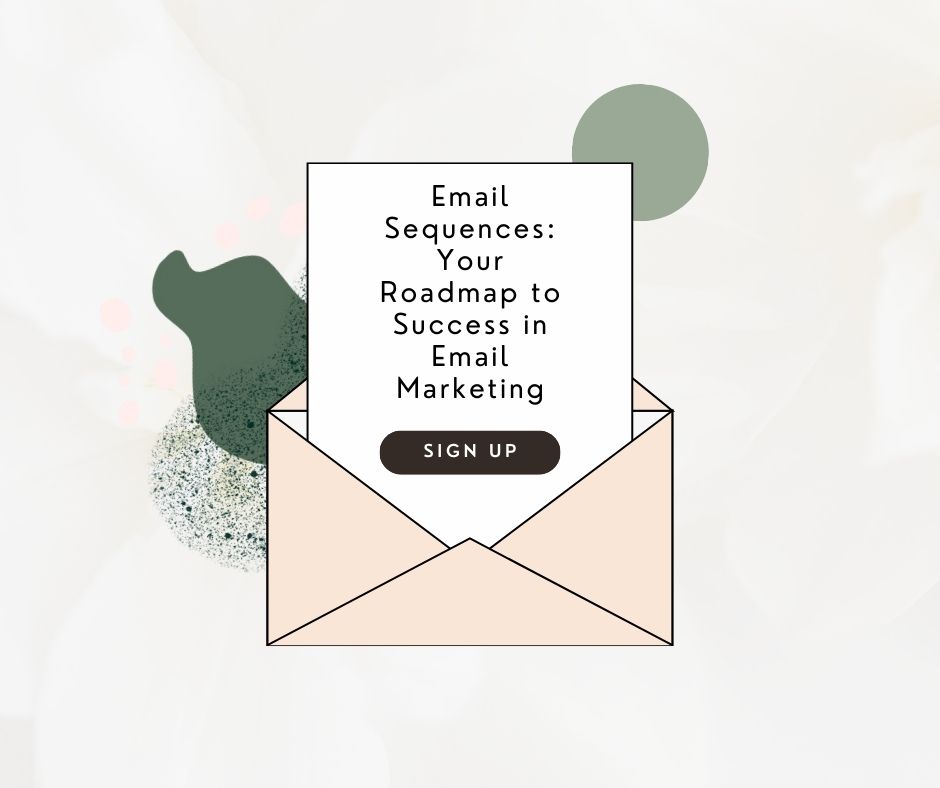In the vast and competitive realm of online marketing, one tool has repeatedly proven its mettle – email. Far from being just an old-school method of communication, email marketing remains an essential part of any successful lead-generation strategy. At Lead-gen-marketing.com, we’re all about educating you on the power of email marketing and, more importantly, how to make it work for your business. This article delves into ‘high converting email sequences’ and how they can be the game-changer your business needs.

What is an email sequence?
An email sequence is a series of pre-written emails that are sent to a group of subscribers or customers over a predetermined period. It is a marketing strategy businesses use to nurture leads, build relationships, and guide customers through a specific sales or onboarding process.
Email sequences are typically automated, meaning that once set up, they are automatically sent out based on a predetermined trigger, such as a subscriber signing up for a newsletter, making a purchase, or abandoning a shopping cart.
The purpose of an email sequence can vary depending on the business’s goals. Some common types of email sequences include:
1. Welcome Sequence: This is often the first email sequence subscribers receive after signing up for a newsletter or joining a mailing list. It aims to introduce the business, provide valuable information or resources, and set the tone for future communications.
2. Nurture Sequence: This sequence is designed to build relationships with subscribers and move them closer to making a purchase. It typically includes a series of educational or informative emails that provide value, establish credibility, and address potential customer concerns.
3. Sales Sequence: This sequence is focused on driving sales. It may include promotional emails, product recommendations, limited-time offers, or upsell opportunities. The goal is to convert leads into paying customers and maximize revenue.
4. Onboarding Sequence: An onboarding sequence is crucial for businesses with software or online service. It helps new users get familiar with the product, guides them through setup or initial steps, and ensures a positive experience.
Why are high-converting email sequences important?
High-converting email sequences are important because they have the potential to impact your business’s bottom line significantly. By effectively nurturing leads and guiding customers through the sales process, you increase the chances of converting them into paying customers.
Here are a few reasons why high-converting email sequences are crucial for your business:
1. Personalized and targeted communication: Email sequences allow you to segment your subscribers or customers based on their interests, behaviors, or stage in the sales funnel. This enables you to send personalized and targeted emails that are more likely to resonate with each individual, increasing the chances of engagement and conversion.
2. Automation and scalability: Email sequences can run on autopilot, sending relevant emails at the right time without requiring ongoing manual effort. This allows you to scale your lead generation and customer nurturing efforts without being limited by time or resources.
3. Building trust and credibility: With a well-crafted email sequence, you can establish yourself as an expert in your industry, demonstrate your knowledge and expertise, and build trust and credibility with your audience. This trust and credibility can significantly influence their decision-making process and increase their likelihood of choosing your business over competitors.
4. Maximizing customer lifetime value: Email sequences can convert leads into customers and nurture and retain existing customers. Send targeted emails that provide value, upsell opportunities, or exclusive offers. You can encourage repeat purchases, increase customer loyalty, and maximize their lifetime value to your business.
5. Personalized customer journey: Email sequences allow you to create a customized customer journey by sending emails at specific intervals based on the customer’s behavior or stage in the sales process. This helps you guide them through the buying journey, address their pain points, overcome objections, and provide the right information at the right time to move them closer to making a purchase.
6. Data-driven optimization: Email sequences provide valuable data and insights into your audience’s behavior, preferences, and engagement levels. Analyzing this data allows you to optimize your email sequences continuously to improve their effectiveness and conversion rates. This data-driven approach ensures you constantly refine your email marketing strategy and get the best results.
In conclusion, high-converting email sequences are crucial for businesses aiming to convert leads into paying customers and maximize revenue. They enable personalized and targeted communication, automation, and scalability, building trust and credibility, maximizing customer lifetime value, creating a personalized customer journey, and data-driven optimization. By implementing effective email sequences, you can increase your chances of converting leads into customers and achieve long-term success for your business.
We will explore the five key aspects: Relevance, Engagement, Actionable tips, Design, and Yield. So buckle up, and let’s begin.
The Magic of Relevance: The Unsung Hero in Email Marketing

In email marketing, the importance of sending relevant emails cannot be overstated. But why is this so crucial? And how can you ensure the emails you send out are indeed relevant? Let’s deep-dive into these questions, exploring the stories of businesses that have excelled in this arena and offering practical, actionable insights you can apply in your email marketing efforts.
The Importance of Relevance: A Tale of Two Emails
Let’s imagine two different emails from two other companies.
First, there’s a generic promotional email from a big-box retailer. Let’s call them Company A. The email announces a site-wide sale covering everything from kitchen appliances to children’s clothing. The email isn’t personalized and doesn’t consider the products that you, as a customer, might be interested in.
On the other hand, there’s an email from Company B, a small online bookstore. This email announces a sale too, but it highlights books from genres you’ve shown interest in and even suggests titles based on your previous purchases.
Both emails announce sales, but which one are you more likely to engage with? Most likely, it’s the email from Company B. The reason is simple: relevance. Company B has sent an email far more relevant to you by understanding your preferences and needs.
This tale of two emails underscores the importance of sending relevant emails in your email marketing campaigns. But how can you ensure your emails achieve this level of relevance?
Getting to Know Your Audience: The First Step to Relevance
The first step to creating relevant emails is to understand your audience. That means understanding their needs, challenges, goals, and preferences. The better you know your audience, the better you tailor your emails to resonate with them.
A great example of a company that does this well is Netflix. Netflix sends personalized emails to subscribers recommending shows and movies based on their viewing history. By doing so, Netflix ensures that its emails are always relevant to its subscribers’ interests.
You can use tools like customer surveys, social media listening, and website analytics to get to know your audience. You can also use demographic and psychographic data to segment your email list, ensuring that each segment receives emails that are relevant to them.
Timing and Frequency: The Role of Cadence in Relevance
It’s not just about what you say in your emails but also when you say it. The timing and frequency of your emails play a big role in their relevance.
For instance, let’s consider a SaaS company that offers a project management tool. If they send an email introducing a new feature just when a user has signed up for a trial, it might not be relevant because the user is still figuring out the basics of the tool. On the other hand, if this email is sent after the user has had some time to explore the tool and understand its features, it’s more likely to be relevant and appreciated.
You also need to consider the frequency of your emails. Too many emails can overwhelm your subscribers and lead to unsubscribes. Conversely, if you don’t email your subscribers regularly, they might forget about you. The right frequency depends on your audience and the nature of your emails.
Relevance is Not a One-Time Thing
Remember, achieving relevance in your emails is not a one-time task. Your audience’s needs and preferences can change, and your email strategy must adapt.
For instance, a company selling baby products must adapt its emails as its customers’ babies grow. The emails relevant to a new mother with a newborn might not be as relevant to her when her baby turns a toddler. Similarly, B2B companies must adapt their emails based on their customer’s business growth and changing needs.
In conclusion, achieving relevance in your emails is a continuous journey. But it’s a worthwhile journey, as it can significantly boost your email open rates, engagement, and conversions. In the following sections, we’ll explore more ways to boost the effectiveness of your email marketing campaigns. Stay tuned.
Engagement: The Beating Heart of High Converting Email Sequences

When we say ‘Engagement,’ what exactly do we mean in the context of email marketing? Simply put, engagement is all about building a dynamic, two-way relationship with your subscribers where they’re not just passive receivers of your content but active participants in the conversation. Engaged customers are more likely to convert, purchase, and become repeat customers, so let’s delve into how you can make that happen.
The Power of Automated Email Sequences
Imagine the subscriber experience as a journey. A single email is like a signpost along the way, but an automated email sequence is an entire roadmap. It guides subscribers from initial sign-up to ultimate conversion, helping you earn their trust and business.
For example, consider the automated welcome email sequence. The welcome sequence is essential to onboarding, setting the tone for your entire relationship with the subscriber. If the welcome email is a handshake, the subsequent emails deepen the conversation, showing the customer that you understand and value them.
Remember, automation isn’t just about ease and efficiency. It’s also about consistency and personalization. An automated email sequence ensures that every subscriber gets a consistent, high-quality experience, and personalization makes that experience relevant to them.
From Prospects to Customers: Different Types of Email Sequences
At Lead-gen-marketing.com, we often discuss how different email sequences serve other purposes in the customer journey. For example:
The Onboarding Sequence: This is the “getting to know you” phase. It’s where you provide educational content about your business and how it can solve the customer’s problems.
The Nurture Sequence: Here, you’re providing valuable, engaging content regularly, building trust, and positioning your business as a reliable source of information.
The Conversion Sequence: This is where you move the prospect towards purchasing. You’ve built trust. Now it’s time to demonstrate clear, compelling reasons why your product or service is the right choice.
The Retention Sequence: After purchase, you want to turn a one-time buyer into a repeat customer. This sequence emphasizes customer support, appreciation, and introducing new products or services that the customer might like.
The Mighty Abandoned Cart Email: A Study in Conversions
A prime example of an effective email sequence is the abandoned cart sequence. Statistics show that almost 70% of online shopping carts are abandoned before the customer completes a purchase. But a left-cart email sequence can recoup some of those lost sales.
The first email in this sequence is a simple reminder: “You left something in your cart!” This serves to jog the customer’s memory. The second email might introduce a sense of urgency: “Your cart items are almost sold out!” And the third could provide an incentive, like a limited-time discount or free shipping.
Like all other email sequences, abandoned cart sequences should be automated and timed appropriately for maximum effect. Software platforms with email automation capabilities can help you easily design and implement these sequences.
Templates, Best Practices, and Conversions
Templates can serve as a useful starting point for your email sequences. They provide a proven structure you can customize to fit your brand’s voice and customers’ needs. But remember, templates are a foundation, not a final product. Your emails should always reflect the unique value that your business provides.
Best practices in email sequences vary depending on your business, customers, and goals.
However, some universal best practices can guide your strategy:
Consistency: Your emails should reflect your brand in tone, design, and content. They should also arrive consistently, not sporadically.
Value: Every email should provide value to the subscriber, whether that’s useful information, an entertaining story, or a special offer.
CTA: Every email should have a clear, compelling call to action. What do you want the subscriber to do after reading the email?
Testing: What works for one business might not work for another. Test different aspects of your email – subject lines, content, CTA placement, etc. – to see what works best for your subscribers.
Remember, the ultimate goal of your email sequences is conversion: turning prospects into customers and customers into repeat customers. And it’s not just about making a sale. It’s about building a long-term relationship based on trust and value. High-converting email sequences can guide you on this path to success.
The Power of Automated Email Sequences: A Real-Life Example
Picture this: A young woman named Sarah is browsing online for skincare products. She stumbles upon an organic skincare brand that captures her interest. She signs up for their newsletter and immediately receives a welcome email thanking her for subscribing and introducing her to the brand’s story and values. Sarah is intrigued.
Over the next few days, she receives a sequence of emails. The first email educates her about the benefits of using organic skincare products. The next introduces her to their popular products with glowing customer testimonials. Another email provides tips on choosing the right skincare products for her skin type. Every email feels personal and relevant as if it were tailored for her.
This level of personalization and consistency in the email sequence leaves a positive impression on Sarah. She finds herself trusting the brand more with each email. Eventually, she purchases her first skincare product from them, won over by the compelling, personalized email sequence.
In this story, email automation software played a pivotal role. It ensured every subscriber, like Sarah, received a consistent, personalized experience. From her welcome email to the email that ultimately led her to make a purchase, every communication was part of a well-planned, automated sequence.
From Prospects to Customers: Different Types of Email Sequences in Action
Let’s consider a SaaS (Software as a Service) company. They’ve launched a project management tool with a robust email marketing strategy.
The Onboarding Sequence: When a subscriber signs up for a free trial of the tool, they receive an onboarding sequence. The first email welcomes them, the next introduces them to the tool’s basic features, and the following emails offer tips and tricks to maximize their trial experience.
The Nurture Sequence: Even after the trial period ends, the company stays in touch with educational content like blog posts about project management best practices, productivity hacks, and customer success stories.
The Conversion Sequence: A conversion sequence is triggered if the trial user doesn’t convert to a paid user. These emails address common objections, offer a limited-time discount, or highlight premium features only available to paid users.
The Retention Sequence: Once the user converts to a paying customer, the retention sequence comes into play. These emails check in on the customer’s experience, introduce them to advanced features, and share resources to help them get more value from the tool.
In these sequences, the company successfully guides the user from the “getting to know you” phase to becoming a loyal customer.
The Mighty Abandoned Cart Email: A Study in Conversions
Let’s revisit Sarah. This time she’s been eyeing a fancy dress from an online fashion store. She adds the dress to her cart but gets distracted and leaves the site.
An hour later, she gets an email: “Sarah, you left something in your cart!”. It’s a gentle nudge, reminding her of the dress she wanted. She ignores it for now.
The next day, another email lands in her inbox. It’s from the same store, saying, “Hurry! Your dress is almost sold out!”. The urgency prompts her to return to the site, but she’s still undecided.
Two days later, she received a final email. “Sarah here’s 15% off just for you!”. With the combined incentive of the discount and fear of missing out, Sarah finally makes the purchase.
This story illustrates how a well-planned abandoned cart email sequence can turn a potential lost sale into a successful conversion.
These examples show how high-converting email sequences can drive customer engagement and conversions.
Unlocking Email Marketing Success: Your Ultimate Guide to Actionable Tips

In email marketing, achieving high conversion rates is no small feat. It demands a potent combination of strategic planning, continuous learning, and keen attention to best practices. We’ll dive deep into email marketing, supplying you with actionable tips to enhance your email performance significantly. We’ll bolster our insights with stories, examples, and recommended workflows to give you a comprehensive view.
Understanding the Power of Audience Segmentation
The story of an online fitness brand provides a compelling illustration of the power of segmentation. The brand had a diverse customer base, ranging from professional bodybuilders to health-conscious individuals aiming to stay fit. Initially, the company sent the same email content to all their subscribers. This resulted in mediocre open rates, click-through rates (CTRs), and a staggering amount of unsubscribes.
The brand decided to segment its email list based on customers’ fitness goals. They began tailoring their messages to each segment, creating personalized workout tips and product recommendations. The result? A whopping 760% increase in email revenue, improved engagement, and a significant reduction in unsubscribe rates.
This is a compelling example of how segmenting your audience and tailoring your messages can supercharge your email performance. Whether you’re segmenting based on demographics, engagement levels, or user behavior, personalized content significantly increases the relevancy and effectiveness of your emails.
The Power of Testing and Optimization
In email marketing, A/B testing is not just a recommendation – it’s a necessity. Our “The Importance of A/B Testing in Email Marketing” guide offers a detailed look at this crucial process.
To illustrate, let’s consider a case study of a clothing retail company. The company struggled with stagnant open rates and tried A/B testing to improve them. They decided to test their subject lines, one of the first elements a recipient sees.
The original subject line was: “Our Summer Collection is Here!” The tested version was: “Get Ready for Summer with Our New Collection!” The second option created a sense of urgency and was more action-oriented. After testing, the second subject line outperformed the original one, resulting in a 25% increase in open rates.
This example demonstrates how seemingly minor adjustments, like tweaking subject lines, rephrasing your call-to-action (CTA), or refining your email design, can change your open rates and conversions.
Harnessing the Power of Personalization
Personalization is a game-changer when it comes to the effectiveness of your email marketing campaigns. Personalized emails can boost your click-through rates by an average of 14%, and increase conversions by 10%.
A fine example is an online bookstore that began addressing customers by their first names in emails and recommended books based on their previous purchases and browsing history. The result? Their open rates, click-through rates, and conversion rates soared, demonstrating how a little personal touch can make a big difference.
The Benefits of Automation
Email automation is like a skilled assistant working 24/7, ensuring that subscribers receive timely and relevant emails. From sending welcome emails to new subscribers and reminders about abandoned carts to reigniting the interest of inactive subscribers with a re-engagement series, automation is an absolute must-have.
Take, for example, an e-commerce site that set up an automated workflow to send out reminders to customers who left items in their shopping carts. These ‘abandoned cart’ emails resulted in a 15% recovery rate of potentially lost sales.
The Importance of Continuous Learning
In the fast-paced world of digital marketing, staying stagnant is not an option. The trends, technologies, and best practices are constantly evolving. To stay ahead, it’s essential to keep learning and adapting.
Consider the story of a startup that initially had decent success with its email marketing. However, they didn’t invest time in learning about the latest trends and strategies, and gradually, their competitors overtook them, causing their conversion rates to plummet.
It’s essential to stay updated and continuously learn to adapt and succeed. Our blog at Lead-gen-marketing.com is a rich resource. Online courses, webinars, podcasts, and industry conferences offer valuable insights and new perspectives.
In conclusion, the path to high-converting email sequences isn’t always straightforward. It requires a deep understanding of your audience, continuous optimization, effective personalization, strategic automation, and an insatiable thirst for learning. Each of these actionable tips serves as a key step in your journey to successful email marketing.
The Power of Design in Email Marketing: Actions Speak Louder Than Words

In email marketing, content, and design work hand-in-hand to capture attention, convey your message, and prompt action. While captivating copy forms the backbone of your email strategy, the role of design cannot be understated. Every aspect plays a critical role in engagement and conversions, from your email layout to the visuals you use. Let’s dive deeper and understand the role of design in email marketing.
Mastering the Art of Email Layout
Your email’s layout determines the path your reader’s eye will follow. It’s an essential component that makes your content accessible and enjoyable. Our article “Mastering the Art of Email Layout” provides a thorough guide.
Let’s consider a real-world example. Jane is a marketing manager for an online clothing store. Initially, their emails were packed with images and text, making it hard for subscribers to digest the information. They revamped their layout, introducing white space and organizing content into digestible sections. This simple action led to a 35% increase in their email click-through rates (CTRs), showcasing the immense impact of a well-thought-out layout.
Leveraging Visual Content in Email Marketing
In the digital age, where users are inundated with information, using visuals in your emails can significantly increase engagement levels. Visuals such as relevant images, infographics, or even videos can make your emails more appealing and memorable.
Consider a case from a nonprofit organization that wanted to increase donations for their cause. Initially, they sent text-heavy emails, resulting in lukewarm response rates. Then, they decided to include a compelling, relevant video in their emails. The video emotionally connected the subscribers to the cause, resulting in a 50% increase in donations, demonstrating the power of visuals.
The Crucial Need for Responsive Design
In our increasingly mobile-centric world, having a responsive design is not optional but an absolute necessity. According to our blog post “Why Responsive Email Design Matters”, most emails are now opened on mobile devices.
A renowned home decor company learned this lesson the hard way. Despite having beautifully designed emails, they noticed their open and click-through rates were dwindling. After investigating, they realized their emails didn’t display well on mobile devices, causing them to lose potential customers. After switching to a responsive design, their engagement metrics improved dramatically, reinforcing the importance of mobile-friendly emails.
Tapping into Color Psychology in Email Marketing
The colors you choose for your emails can profoundly impact your audience’s emotions and responses.
A compelling example is a software company that wanted to promote its new productivity app. They decided to use blue prominently in their emails, a color associated with trust, peace, and productivity. This strategic use of color psychology increased their download rates, showing that color is not just about aesthetics but about evoking the right emotions.
Crafting Powerful Calls to Action (CTA)
A compelling CTA is like a climax in a story, a point where an interested reader turns into a converted customer. Check out our guide “Creating Powerful CTAs in Email” to craft effective CTAs.
Take the example of an e-commerce store selling handmade soaps. They had well-crafted emails, but their CTAs were often lost in the design. They made their CTAs stand out by using contrasting colors and action-oriented text. This change led to a 20% increase in their sales, underlining the crucial role of CTAs in driving conversions.
As design expert
Nathasa Zdravkovska said, “Design creates stories, and stories create memorable experiences, and great experiences have this innate ability to change how we view our world.” Your email’s design should look good and align with your brand, facilitate a seamless experience for the reader, and prompt them to take action. Understanding and applying these design principles can significantly enhance your email marketing performance.
Yield: The Comprehensive Guide to Success in High-Converting Email Sequences

Yield, often synonymous with return on investment (ROI), is a critical measure of the success of your email sequences. As such, achieving a high yield is an art that requires mastery of several key elements. This comprehensive guide delves into yield in email marketing, illuminating its importance, components, and how to optimize it for success.
Understanding Yield Beyond Direct Sales
While direct sales are an obvious and measurable result of successful email sequences, yield in email marketing encompasses much more. Yield can also be measured by several other metrics such as open rates, click-through rates (CTR), conversion rates, and subscriber growth.
Let’s consider the story of a local gym named “FitLife.” Initially, they were solely focusing on direct sales through their email marketing. However, when they started tracking other metrics, such as open rates and subscriber growth, they were able to gain a deeper understanding of their audience’s interests and behavior, leading to more targeted and effective campaigns, ultimately boosting their yield significantly.
Exploring the Components of Yield
To grasp the full scope of yield, let’s break down its main components:
-
- Open Rates: This is the percentage of recipients who open your emails. High open rates reflect the effectiveness of your subject lines and the interest of your audience in your content. For example, a renowned fashion brand saw a tremendous spike in its open rates when it started personalizing its subject lines, showcasing the power of personalization in email marketing.
-
- Click-Through Rates (CTR): This measures the percentage of recipients who clicked on one or more links in your email. High CTRs indicate that your email content and CTAs are compelling and engaging. A fascinating case study in this context is a software company that doubled its CTR by making its CTAs more prominent and action-oriented.
-
- Conversion Rates: This is the percentage of recipients who complete a desired action, such as purchasing, downloading a resource, or filling out a form. High conversion rates reflect the effectiveness of your email sequence in driving the desired actions. Consider the case of a SaaS business that improved its conversion rates by 30% by segmenting its audience and tailoring its offers accordingly.
-
- Subscriber Growth: This shows the rate at which your email list is growing. It signifies that your content is attractive enough for more people to want to receive it regularly. For instance, a popular cooking blog saw a three-fold increase in its subscriber growth rate when it started offering exclusive recipes for subscribers.
Tracking and Optimizing for High Yield
Once you understand the components of yield, the next step is to track and optimize these metrics.
The power of optimization was clearly demonstrated by an online bookstore. They continually tested different email formats, subject lines, and content types to see what resonated best with their audience. This relentless pursuit of improvement led to a 60% increase in their email yield.
Peter Drucker, the father of modern management, once said, “Marketing aims to know and understand the customer so well the product or service fits him and sells itself.” This perfectly captures the essence of achieving a high yield in email marketing. You can naturally improve your yield by making your emails relevant, engaging, actionable, and well-designed.
Creating high-converting email sequences is a holistic process that involves relevance, engagement, actionable tips, design, and yield. Each element plays a pivotal role and must work harmoniously to generate the best results.
At Lead Gen Marketing, we’re committed to helping you master these elements and excel in email marketing. We hope this comprehensive guide on yield has brought you one step closer to that goal. Contact us today if you’re ready to take your email marketing to the next level. We can provide personalized guidance and tools to boost your yield and achieve success in email marketing.
Stay tuned for more resources, and remember, every email is an opportunity to connect with your audience and grow your business. Happy emailing!


No responses yet